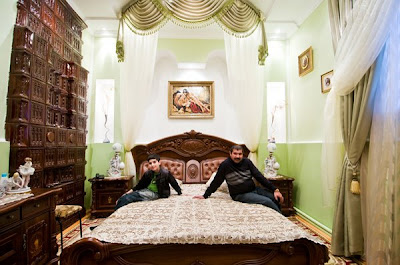
What do you think of Yale's Art & Architecture Building (above)? People who don't like it call the style "brutalist," which is a good name for the kind of bleak, concrete boxes that were built from the 50s to the 70s, but I'm not sure that name applies here. I concede that the building has a lot of brutalist aspects, but it's simultaneously innovative and imaginative, don't you think?

I like the idea of an indoor village (above) where the offices are like raised houses separated by grass. It's not very practical and it wastes space, and it must inhibit communication between the workers, but it's kinda fun and that counts for something surely.

This interior (above) looks like Frank Lloyd Wright's "Falling Water" house. Did he invent those long, concrete balcony railings coming off brick-shaped vertical supports?
I like the way the interior is on different levels. This must drive handicapped people nuts, but it's fun for the rest of us.

It's weird to see a whole building made out of what looks like kids building blocks. You can buy natural wood building blocks with most of these shapes, including the flat planks. They're great to keep in a basket next to a coffee table, but you need to buy more than one set to build anything decent.
These horizontals and verticals are interesting in small doses, but a bit hard on the eye over time.

The Greek statue (above) is simultaneously out of place, and not out of place in this modernist library room.

The Yale arts building is done in a kind of vertical/horizontal modernism that's out of fashion now. Everything now is diagonal, chaotic, and deliberately disorienting. That's OK, I don't mind being dis-oriented, it's fun, but I hate obsessively blank walls and wind traps like some of the facets on the building above.

This building (above) looks like a cubist bird. It's weird, and inadequately lit on the upper floors, but I'd still like to live in it.

Back to the Yale building: some of the spaces (above) succeed in being wide and tall at the same time. That's a neat trick. You can see how he does it with the lights. Wide rooms with bright, flat-colored carpets are appealing at first glance and tiring after that.

The LA County Art Museum has steps like the ones on the Yale building above. It's odd to see steps, which imply power and grandeur, tucked away in an almost claustrophobic crevice. I think this is the main entrance.

Boy, you feel like you're walking along ancient Egyptian temples, except everything is obsessively clean and straight, and lacking in detail.

Modern architecture (above) has its good points, but it sure wastes space.

You can see why the building (above) is regarded as brutalist. Outside it's a concrete wind trap.

The interlocking concrete rectangles are definitely interesting. Looking at them makes me aware of the marvelous design possibilities that concrete makes possible, but it also makes me aware of its limitations. The look is intriguing, but cold as ice.

These balcony railings look like they're made of wood, but they're done in the style of flat, modernist concrete railings. It looks OK, but it's a waste of good wood to use it to copy minimalist forms made for concrete.
I have to admit that I'm conflicted about this building. What do you think?




















































